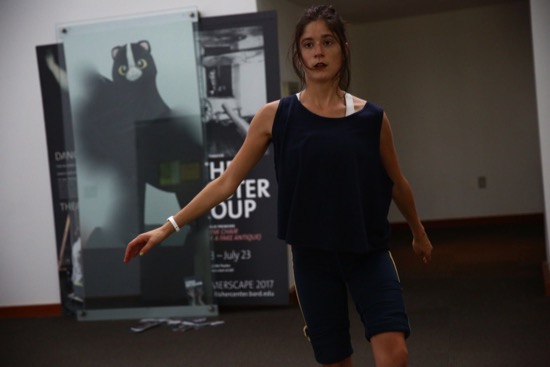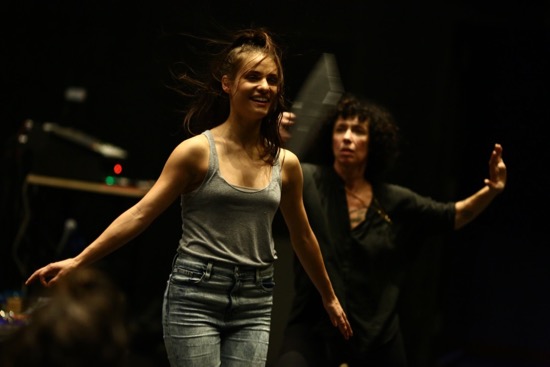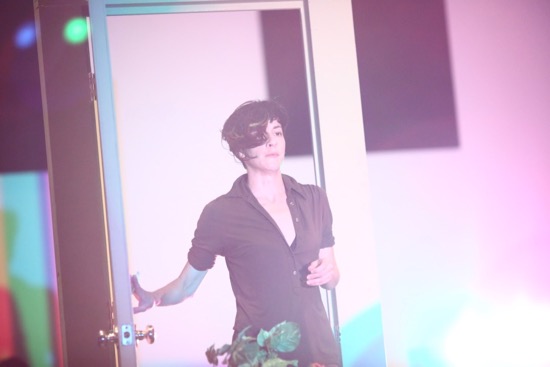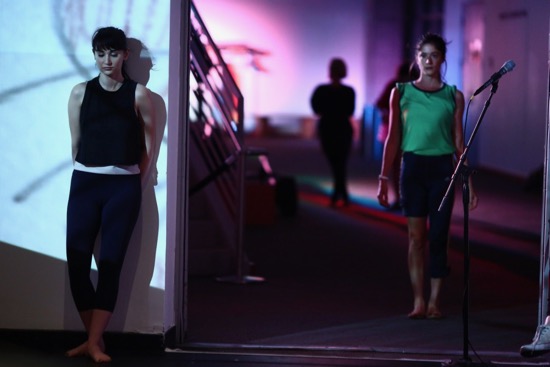Sarah Michelson premieres a new work at Bard College’s Richard B. Fisher Center.

The hand that controls the phone, or vice versa. Sarah Michelson’s September2017/\. Photo: Paula Court
If a friend tells me he or she is going to see a particular choreographer’s new work, I nod my head; I have a vague idea of what it’ll be like. But suppose the choreographer named is Sarah Michelson. That’s a whole other story. I’ve walked into downtown New York theaters such as The Kitchen and P.S. 122 to see a Michelson work and had to orient my perspective; I appeared to be in a space I’d never seen before. In Shadowmann: Part 1 (2003), we sat on bleachers facing The Kitchen’s entry; at some point two sets of doors opened to reveal Michelson and Parker Lutz sitting on a stoop across 19th Street; then they walked over and joined us in the space. She can even make a gallery in the Whitney Museum of American Art look different (Devotion Study #1—The American Dancer, 2012); it was performed on a white floor printed with architect Marcel Breuer’s ground plan for the building. Her sensitivity to architecture is remarkable.
I can also guess that in a piece by Michelson, she will talk and that the scenery and lights will be remarkable. Other aspects are harder to predict. You don’t usually envision, say, a twelve-year-old girl (Non Griffiths, who had worked with Michelson in Wales) doing a synchronized duet with an adult female, the two of them dressed like deconstructed jockeys (Devotion, 2011). During Group Experience (2001), for which the choreographer created a shallow, carpeted theater within the downstairs theater at PS 122, Nancy Alfaro was part of the “décor,” knitting a scarf that had become about ten feet in length.
Last week, she premiered an astonishing new work at Bard College in Annandale-on-Hudson. Enigmas abound. Start with the title: September2017/\. Then learn that Michelson, invited to create a piece for the campus’s Richard B. Fisher Center, elected to work with a group of student dancers for four years. Four of those students appear in September2017/\: Rebecca Capper, Rebecca Ganellen, Joanna Warren and Anna Witenberg, all of whom graduated from Bard in 2017. To them, she has added New York dancers Rachel Berman, Jennifer Lafferty, and Madeline Wilcox. Plus herself.
What is this event “about?” Better not to ask. Codes that we may think we can decipher, but can’t? Slippage between elements that appear to coincide, but don’t? There are moments when we’re not sure who’s in charge of whom. What we take to be improvising or running amok on the part of the performers may be scrupulously planned. Michelson thinks hard about every aspect of performance and its cultural linkages. September2017/\ is also infused with allusions to the college, these dancers, and spectatorship as a chancy business. At the end of the first part, Jaleel Green (who will graduate from Bard in 2019) walks to a microphone and says “Hello everyone. Here’s the piece I’ve been working on with my beautiful dancers.” After Roobi Gaskins ’19, Greta Grisez ’19, Sakinah Bennett ’21, and Olivia Troiano ’20, looking very good, perform his short, very nicely constructed dance, we applaud, and he says “thank you” into a mic on the opposite side of the stage.

Joanna Warren dancing in the lobby of Bard’s Luma Theater. Photo: Paula Court
While we’re waiting in the lobby for the performance to begin, Warren dances for us. She has a repertory of short variations on a theme. Each one ends as a smart phone rings a little tune; she repairs to it, checks something, and clicks it into silence. She also announces most of the variations in a code we may strive to divine: a combination of letters and numbers. The choreography is precise, engrossing, and she turns to show it from several perspectives. Her arms, mostly straight, swing from the shoulders; her feet are busy, her body mostly erect. Nothing we see in Bard’s intimate Luma Theater will resemble it in terms of dance ingenuity and virtuosity as we usually define them.
Even before entering, we can hear voices shrieking and muttering. The main performing area is empty, except for three remote-controlled cars about a foot in length, and Zack Tinkelman—who’s been designing light for Michelson for six years—initially gives the space a harsh cast and occasionally startles us with glare. Various noise-making objects sit on a low table beside the stage’s small pit. Beside that, stands a console too complex for me to understand. Michelson controls its buttons, levers, and knobs, making her own voice repeat, become a chorus, join other voices, get louder, diminish, speed up to Donald-Duck gabble. She whispers, yells (“hello” and “goodbye” become a rhythmic litany). Other sounds intrude. Her phone periodically tinkles out that warning tune. She hunches over her equipment like a witch stirring her cauldron, doing a kind of dance impelled by her labor—feet pumping, pelvis swinging, hands flying about their tasks.
Two of the cars start running backward in circles; Ganellen controls them from one side of the stage. The raucous sounds stop so we can hear their wheels turn. The cars are still, when Rachel Berman enters on roller skates. She eschews tricks like arabesques and pirouettes, just glides coolly around, straddling the cars as she goes, sailing into a lunge, once spreading her legs very far apart, as if contemplating doing a splits. Michelson speaks in a high little-girl voice: “s,w,i,a,t,s,f.” (was that it?). Sometimes her voice is so quiet that it’s barely audible.

Madeline Wilcox (L) and Sarah Michelson in Michelson’s September2017/\. Photo: Paula Court
Ordeal sometimes plays a role in Michelson’s world. We suffer with Wilcox, who gives no indication of suffering. She doesn’t exactly “dance,” although she walks from place to place or poses facing different directions. Her whole body is involved in delivering the same words over and over in a loud strong voice, with intermittent pauses. The main words are “yeah!,” “hold!,” and “back up!,” occasionally “peace” and “drop off.” At one point, she seems to be aiming these emphatic utterances at a man who watches from one side of the stage, occasionally disappearing; I imagine him watching for cues to change the lighting. At first, I strain to decipher her words, mistaking “back up” for “grandma.”
“Grandma” isn’t that far-fetched, Michelson both soothes Wilcox and eggs her on in what turns into increasingly arduous labor. The choreographer swipes the dancer’s legs and belly with a mic, although no loud sound is heard. “You wanna soda?” she asks, but doesn’t proffer one. She accompanies Wilcox with a “whirly tube” (remember them from the 1960s?) and attempts to cool her with a big, black fan, while blowing the whistle in her mouth (Wilcox tosses her head, adding her ponytail to the wind). Michelson also fans her with a thin piece of plywood, for a few seconds pressing it under her chin, as if to encourage good posture. Once, she says, “I love you, honey,” before hurrying to squeeze the black bulb on an old-fashioned car horn to make it honk.
I can’t adequately convey how much bustling around Michelson does and how much noise she creates at her console and with her equipment (which once includes bells on each finger) and how I feel for Wilcox. I want to scream for quiet and slowness (just once or twice, Michelson talks in a casual, everyday voice). Briefly, Witenberg arrives to add her presence and voice to the proceedings, seconding what Michelson proscribes. Ganellen launches another car; this one has no lights. A second one crashes into it. Just before Witenberg exits, she gives Wilcox an order, “Open your eyes, honey.”
After we view Green’s piece for the current Bard students, we’re ushered into another room—a dance studio by the looks of it. The atmosphere is nothing like what we’ve just seen. Or is it? And what have we seen anyway? A teacher or coach with a student? A mother pushing her valiant, obedient, almost robotic daughter into a career (and what a limited career it seems to be)?

Jennifer Lafferty in the second half of Sarah Michelson’s September2017/\. Photo: Paula Court
Compared with the bleak black, white, and gray atmosphere of September2017/\’s first part, the second is almost garishly colorful, mostly because of the gels on Zinkelman’s spotlights. You could turn a bit pink yourself as you walk into a large studio and sit on three sides of it—either on the floor or perched on heating units that run along the wall. This space is full of stuff. There’s a small, dinky chaise at one end; Witenberg sits on it, talking into a white telephone and making notes on a pad of paper. Michelson (who starts Part 2 lying half under the chaise, only her legs visible) spends much of her time sitting in an Adirondack chair opposite Witenberg and some distance away.
Other items include two small platforms, a large tire set on end, a free-standing door with a couple of potted plants blocking it, papers, a shifting projection of a cat’s head and an owl (maybe), with the words: “back up.” Does this means we’re witnessing the prelude to what we just saw in the theater? Each of the performers has an individual task (or ordeal or fit). Capper works hard at what ought to be pretty simple to accomplish. She wants to stand on one or the other of the boxes; she lunges deeply and plants her front foot on one, rocking back and forth, but, for the longest time, can’t make the final push. She appears to be rationing her energy—announcing to us a 7% effort and finally a 15% one.
Suddenly a newcomer appears: it’s Lafferty, and she performs a long, disturbing solo. Tall and skinny, she’s hunched over most of the time, convulsing and thrashing as she travels around with big, low-to-the-ground steps. For a few moments, she has what looks like an unlit cigarette stuck in her mouth. What is wrong with her? Michelson watches her with concern, as if she’s off course, isn’t doing what she’s supposed to do. Without moving to help Lafferty, Witenberg among her pillows and Michelson in her chair speak and gesture to her (or about her) in a code that we can sometimes interpret, sometimes not. It’s hard to discern whether she’s responding or not. Witenberg says, “We love you,” but without much assurance. Lafferty continues with her tantrum. Only once does she stand up straight. That’s just after she flings the door open, knocking the potted plants over. (“We love you,” we hear again.) If she appears empowered, it’s not, I suspect, because of the directions of others.

Rebecca Capper (L) and Joanna Warren by the door to the lobby. Photo: Paula Court
I imagine Michelson putting autobiography, Bard events, students’ skills and preoccupations, and much more into a kind of art-oriented cyclotron—whirling them into bits and then reassembling them, trimming and polishing as she goes. There’s something profoundly personal about the mystifying images that continue to nag at me days after the performance. A related project, October2017/\, will premiere at The Kitchen next month; I don’t dare make any predictions.
Near the end of September2017/\, Warren reappears in the small lobby outside the door, now wearing a green shirt and dancing full out again. One whole side of the audience cranes to see her and can’t; a few people walk out another door to get a better view. When she’s done, she marches in and announces into a microphone. “This your chance to see me close up. I used to be a Bard student.” And, of course, we have seen her at much closer range, dancing in the lobby before the piece began. No, wait. That was how the piece began. Out in the lobby, two canisters stoked with dry ice smoke to beat the band. That’s life: smoke and mirrors much of the time. I feel as if I’ve been sucked into somebody’s dreams and wonder how I’m going to be able to drive home in the dark.

Thank you for leading us through these mysteries.
This piece was no mystery. One of the worst attempts at dance/theater ever. Saying it’s coded and cryptic is kind. If this was made by a newcomer, it would end their career. Yes, the performers did a terrific job.. The choreographer did not. So why not hold her accountable?